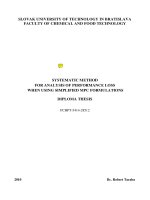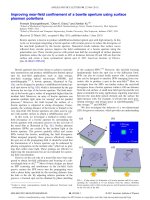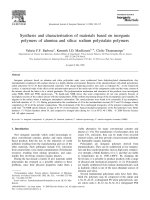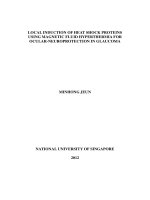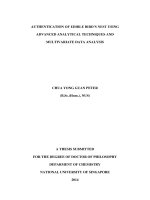Characterisation of carbonate reservoir heterogeneity using borehole image logs
Bạn đang xem bản rút gọn của tài liệu. Xem và tải ngay bản đầy đủ của tài liệu tại đây (6.39 MB, 42 trang )
Carbonate heterolithic classification/1
Image log & dipmeter analysis course
Image log & dipmeter analysis course
Characterisation of carbonate reservoir
Characterisation of carbonate reservoir
heterogeneity using borehole image logs
heterogeneity using borehole image logs
Carbonate heterolithic classification/2
1 km
100 m
200 microns
Scales of carbonate reservoir heterogeneity
Scales of carbonate reservoir heterogeneity
Carbonate heterolithic classification/3
•
Borehole imaging tools
•
Heterogeneities
–
Structural – fractures/faults
–
Depositional and diagenetic
–
Pore system evaluation
•
Reservoir rock typing
•
Conclusions
Outline
Outline
Carbonate heterolithic classification/4
channels
channels
reefs
reefs
slide blocks
slide blocks
0.1 mm 100 m 1 km 10 km1 m 10 m1 cm 10 cm1 mm
CORE
CORE
(Limited Coverage)
BOREHOLE IMAGES
BOREHOLE IMAGES
3D SEISMIC
3D SEISMIC
(Limited Resolution)
fracture width
fracture width
ripples
ripples
dish structures/dewatering
dish structures/dewatering
bioclasts
bioclasts
soft sediment deformation
soft sediment deformation
scours/erosion surfaces
scours/erosion surfaces
grain size/bed thickness trends
grain size/bed thickness trends
bedforms
bedforms
channel lags
channel lags
slumps
slumps
Scales of investigation
Scales of investigation
Carbonate heterolithic classification/5
•
Fractures
–
Closed or open
–
Natural or drilling induced
–
Orientation, spacing and frequency
•
Faults
–
Determine strike and dip of the fault
–
Determine rock displacement along the
fault
–
Reservoir compartmentalisation
•
In-situ stresses
–
Borehole breakout
–
Drilling induced fractures
–
Potential & artificial fracturing
•
Input to fracture modeling
Static
Dynamic
3 6 7 2
N
Structural heterogeneities
Structural heterogeneities
Carbonate heterolithic classification/6
Micro-resistivity
Acoustic
Fracture
Bedding
Feature classification and characterisation
Feature classification and characterisation
Carbonate heterolithic classification/7
15 ft
Non-stylolitic, conductive, bed boundary
(a)
9 ft
Conductive fault with resistive halo
(f)
Conductive fracture cutting resistive fracture
5 ft
(e)
Stylolitic, conductive, resistive & mixed fractures
15 ft
(d)
9 ft
Resistive fracture
(c)
15 ft
Stylolitic, conductive bed boundary
(b)
15 ft
Non-stylolitic, conductive, bed boundary
(a)
9 ft
Conductive fault with resistive halo
(f)
Conductive fracture cutting resistive fracture
5 ft
(e)
Stylolitic, conductive, resistive & mixed fractures
15 ft
(d)
9 ft
Resistive fracture
(c)
15 ft
Stylolitic, conductive bed boundary
(b)
15 ft
Non-stylolitic, conductive, bed boundary
(a)
15 ft
Non-stylolitic, conductive, bed boundary
15 ft
Non-stylolitic, conductive, bed boundary
15 ft15 ft
Non-stylolitic, conductive, bed boundary
(a)
9 ft
Conductive fault with resistive halo
(f)
9 ft
Conductive fault with resistive halo
9 ft
Conductive fault with resistive halo
9 ft9 ft
Conductive fault with resistive haloConductive fault with resistive halo
(f)
Conductive fracture cutting resistive fracture
5 ft
(e)
Conductive fracture cutting resistive fracture
5 ft
Conductive fracture cutting resistive fracture
5 ft
Conductive fracture cutting resistive fracture
5 ft5 ft
(e)
Stylolitic, conductive, resistive & mixed fractures
15 ft
(d)
Stylolitic, conductive, resistive & mixed fractures
15 ft
Stylolitic, conductive, resistive & mixed fractures
15 ft
Stylolitic, conductive, resistive & mixed fractures
15 ft15 ft
(d)
9 ft
Resistive fracture
(c)
9 ft
Resistive fracture
9 ft
Resistive fracture
9 ft9 ft
Resistive fracture
(c)
15 ft
Stylolitic, conductive bed boundary
(b)
15 ft
Stylolitic, conductive bed boundary
15 ft15 ft
Stylolitic, conductive bed boundary
(b)
Micro-resistivity images in horizontal well displayed as pseudo-core sticks
Feature classification
Feature classification
Carbonate heterolithic classification/8
CBIL
sm
ACOUSTIC
EARTH Imager
sm
GR HEXDIP
sm
5m
Fracture identification in oil based mud systems
Fracture identification in oil based mud systems
Carbonate heterolithic classification/9
•
For resistivity images:
–
Conductive (dark image) =/= Open?
–
Resistive (light) =/= Closed?
•
For Acoustic Images
–
low amplitude (dark) =/= Open?
–
high amplitude (light) =/= Closed?
•
Core calibration can be used to confirm
–
Image logs can only provide an interpretive
insight only
•
Only dynamic data provide true insight into
fracture “producibility”
Open versus closed fractures
Open versus closed fractures
Carbonate heterolithic classification/10
Flowmeter data
Conductive
(open) fractures
Acoustic
Calibration of image log data with core
Calibration of image log data with core
Carbonate heterolithic classification/11
Fault identification
Fault identification
Carbonate heterolithic classification/12
BIU 1
BIU 3A
BIU 2
BIU 3B
Formation
Test
Data
(psi)
110.3
26.2
26.2
25.5
10.4
11.8
9.5
12.8
8.9
8.6
7.9
BIU 3B
BIU 2
BIU 1
Bedding contact
WSW
ENE
MINOR
FAULT B
MINOR
FAULT A
MAJOR
FAULT A
BIU 3A
Fault compartmentalisation
Fault compartmentalisation
Carbonate heterolithic classification/13
•
Well and fracture orientation
•
Fracture density
•
Core density calibration
•
Borehole corrected
fracture density
•
Fracture spacing
•
Fracture length?
•
3D modelling
Schematic path
down borehole
(69* / 210*)
Schematic path
down borehole
(69* / 210*)
Mesozoic carbonate
Oil staining
OBLIQUE-SLIP
Fracture distribution
Fracture distribution
Carbonate heterolithic classification/14
•
Increased compartmentalisation
–
Permeability barriers
•
Increased communication
–
Permeability conduits
•
Overall objective - producibility
–
Fracture model inputs
–
Fault seal predictions
–
Production enhancement
–
Completion strategy
–
Selection of perforation intervals
GO
GO
Fracture characterisation
Fracture characterisation
Carbonate heterolithic classification/15
•
Image facies assigned on basis of image
character, open hole log response
•
Image response is related to electrical or
acoustic properties, responds to rock
texture, fluid saturation and mineralogy
•
Not possible to distinguish all core
lithofacies
•
Calibration with core allows a meaningful
geological interpretation of image logs
Image facies
Image facies
Carbonate heterolithic classification/16
Stylolitic seams
Conductive,
tension gashes
Resistive
cemented
limestone
Dissolution
seam
Stylolites and dissolution seams
Stylolites and dissolution seams
Carbonate heterolithic classification/17
Cross-bedding
Cross-bedding
Carbonate heterolithic classification/18
STATIC DYNAMC
STATIC DYNAMCSTATIC DYNAMC
STATIC
DYNAMC
STATIC DYNAMC
STATIC
DYNAMC
Nodular limestone image facies
Nodular limestone image facies
Carbonate heterolithic classification/19
0
10
20
30
40
50
60
% B-Zone
Image facies
0
10
20
30
40
50
60
% B-Zone
Image facies
0
10
20
30
40
50
60
% B-Zone
Image facies
0
2
4
6
8
Average thickness (ft)
Image facies
0
2
4
6
8
Average thickness (ft)
Image facies
0
2
4
6
8
Average thickness (ft)
Image facies
0
2
4
6
8
Average thickness (ft)
Image facies
Well 4 - uncored
Well 3
Well 2
0
10
20
30
40
50
60
% B-Zone
Image facies
Well 1
IF1 IF2 IF3 IF4 IF5 IF6 IF7 IF8 IF9 IF10 IF11
Image facies
Image facies
statistics
statistics
Carbonate heterolithic classification/20
•
Identification, orientation and
analysis of primary stratification
surfaces/heterogeneities
•
Identification of key stratal
surfaces
•
Borehole image facies analysis
•
Depositional modelling
•
Sequential analysis
•
Pore fabric analysis
•
porosity and permeability
distribution
•
Palaeotransport/reservoir
geometry analysis
Depositional heterogeneities
Depositional heterogeneities
Carbonate heterolithic classification/21
Thin bed identification
below the resolution of
openhole logs
STAT
DYN
MINIPERM
PROFILE
High resolution image log response
High resolution image log response
Carbonate heterolithic classification/22
Resistivity Image Resistivity ImageAcoustic Image Acoustic ImageResistivity Image Resistivity ImageAcoustic Image Acoustic Image
Reef core
Back-reef lagoon
Image log facies analysis – reef facies
Image log facies analysis – reef facies
Carbonate heterolithic classification/23
Oil based mud
Facies stacking patterns and dip analysis
Facies stacking patterns and dip analysis
Carbonate heterolithic classification/24
Image facies show
an overall
coarsening/ shoaling-
upward trend with
increasing stacking
pattern in upper part
of reservoir
Stacked
fining-upward
grain/pack/
wackestone
units
Mostly trendless
succession of
mudstone/
wackestones
Interpretation
Coarse, vuggy rudist
float to rudstones
Image facies prediction in uncored wells
Image facies prediction in uncored wells
Carbonate heterolithic classification/25
Reservoir architecture
Reservoir architecture
